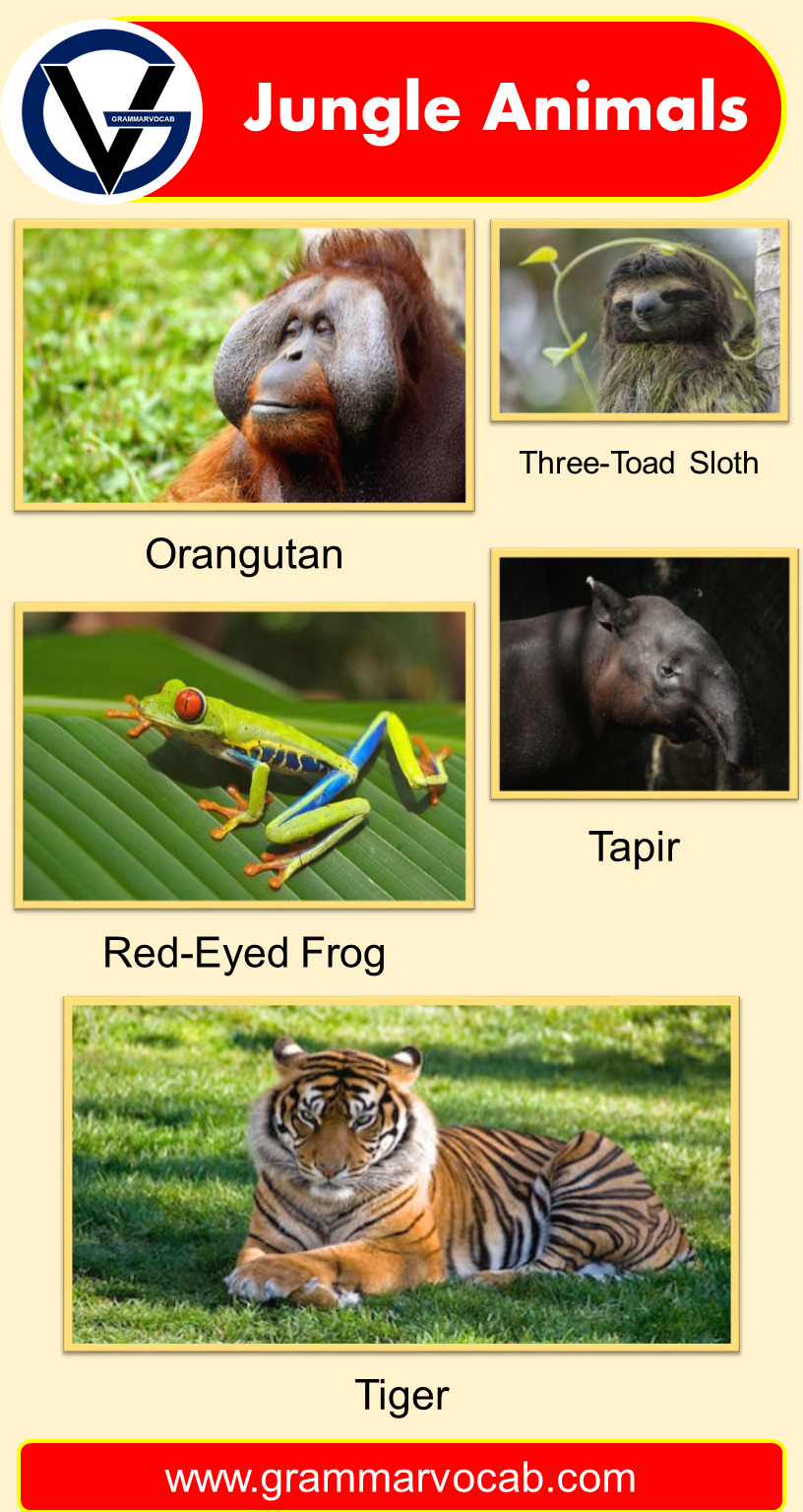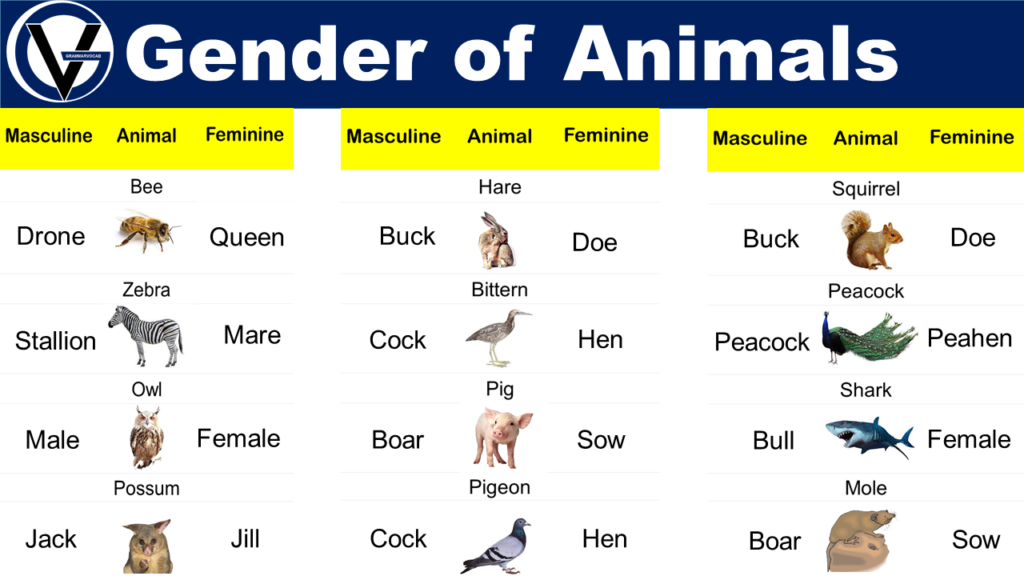The jungle is home to some of the most amazing animals on the planet. From the smallest insects to the biggest mammals, the jungle is teeming with life. In this blog post, we will take a look at a list of jungle animals.
Download Jungle Animals Pictures PDF
Jungle Animals Names List
Here is a list of some animals found in the jungle:
- One-Horned Rhino
- Red-Eyed Frog
- Black Howler Monkey
- Armadillo
- Tiger
- Lemur
- Three-Toad Sloth
- Leopard
- Gorilla
- Toucan
- Tapir
- Jaguar
- Lazy Bear
- Asiatic Lion
- Orangutan
- Madagascar
- Emerald Boa
- Chimpanzee
- Sloth Bear
- Macaw
- Bengal Tiger
- Lion
- Elephant
- Cheetah
- Python
- Anaconda
- Crocodile
- Hippopotamus
- Rhinoceros
- Giraffe
- Zebra
- Wildebeest
- Buffalo
- Hyena
- Baboon
- Mandrill
- Gibbon
- Capuchin monkey
- Spider monkey
- Squirrel monkey
- Howler monkey
- Sloth
- Anteater
- Pangolin
- Parrot
- Hornbill
- Kingfisher
- Peacock
- Ostrich
- Alligator
- Iguana
- Komodo dragon
- Cobra
- Viper
- Poison dart frog
- Tree frog
- Butterfly
- Bee
- Ant
- Beetle
- Jaguarundi
- Serval
- Civet
- Aye-aye
- Red panda
- Sun bear
- Binturong
- Kinkajou
- Margay
- Fishing cat
- Reticulated python
- Black mamba
- Nile monitor
- Green anaconda
- Gharial
- Manatee
- Capybara
- Agouti
- Red howler monkey
- Tarsier
- Proboscis monkey
- Fossa
- Coati
- Red-eyed tree frog
- Harpy eagle
- Pygmy owl
- Fruit bat
- Leaf-tailed gecko
- Electric eel
- Giant anteater
- Saki monkey
- Golden lion tamarin
- Kudu
- Bushbuck
- Okapi
- Bongo
- Horned guan
- Quetzal
- Coatimundi
- Agami heron
- Flying squirrel
- Chameleon
- Leafcutter ant
- Puma
- Bushbaby
- Caiman
- Tamarin
- Fennec fox
- Ruffed lemur
- Leaf-nosed bat
- Aardvark
- Dhole
- Barbary macaque
- Dwarf mongoose
- Giant otter
- White-handed gibbon
- Black caiman
- Blue morpho butterfly
- Dwarf crocodile
- Bushmaster snake
- Sunda pangolin
- Hoatzin
- Red river hog
- Emerald tree boa
- Puff adder
- Spectacled bear
- Sunbird
- Bornean orangutan
- Kookaburra
- Indian peafowl
- Red colobus monkey
- Barking deer
- Nile crocodile
- Emerald tree monitor
- Malayan tapir
- Bornean clouded leopard
- Siamang
- Blue poison dart frog
- Goliath birdeater spider
- Pudu
- Matschie’s tree kangaroo
- Crested porcupine
- Philippine eagle
- Vampire bat
- Geoduck clam
Facts About Jungle Animals
Here are some interesting facts about jungle animals:
- The chameleon is known for its ability to change its color to blend in with its surroundings. However, their color changes are not solely for camouflage but can also reflect their mood, temperature, and social signals.
- The proboscis monkey has an extremely long and prominent nose that can grow up to 7 inches in length. It is believed that the nose helps to amplify their calls and is a characteristic used in sexual selection.
- The tiger is the largest cat species in the world and can be found in jungle habitats. They are excellent swimmers and are known to take down prey in the water.
- The Amazon river dolphin, also known as the pink river dolphin, is a freshwater dolphin that inhabits the Amazon and Orinoco river systems. It is known for its distinctive pink coloration and has a flexible neck that allows it to maneuver through flooded forest areas.
- The orangutan is the largest tree-dwelling animal in the world. They spend most of their lives high up in the trees and rarely come down to the ground.
- The piranha is a carnivorous fish found in jungle rivers. They have sharp teeth and a reputation for their feeding frenzies, although they mostly feed on smaller fish, insects, and plants.
- The spider monkey is known for its incredibly long limbs, which help it swing through the trees with ease. They are highly agile and can cover large distances by brachiating from branch to branch.
- The Amazon rainforest is home to the largest variety of primates in the world, including species like the capuchin monkey, marmosets, and tamarins.
- The boa constrictor is a large, non-venomous snake found in the jungle. They capture and suffocate their prey by coiling their muscular bodies around them.
- The tapir is a unique jungle mammal that resembles a cross between a pig and an anteater. They are excellent swimmers and have a flexible snout that they use to forage for food.
- The jungle cat, also known as the reed cat, is a small wild cat species that inhabits various jungle regions. They are excellent hunters and have adapted to diverse environments, including wetlands, grasslands, and forests.
- The spectacled caiman is a small crocodilian species found in South American jungles. Despite their small size, they are formidable predators and play a vital role in maintaining the ecosystem’s balance.
- The bushmaster snake is one of the deadliest venomous snakes in the jungle. They are known for their potent venom and are capable of delivering a lethal bite.
- The scarlet macaw is a vibrant and colorful parrot species found in the jungle. They are known for their beautiful plumage and can live up to 50 years in the wild.
Must Learn: List Of Smartest Animals
FAQ Related to Jungle Animals
Q: Are there any endangered jungle animals?
A: Yes, unfortunately, many jungle animals are endangered or threatened due to habitat loss, poaching, and other human activities. Animals such as the Sumatran orangutan, Bornean pygmy elephant, and Javan rhinoceros are just a few examples of jungle animals that are critically endangered.
Q: How do jungle animals adapt to their environment?
A: Jungle animals have evolved various adaptations to survive in their dense and often challenging environments. Some animals have developed excellent camouflage to blend in with the surroundings, while others have specialized climbing abilities, sharp senses, or unique feeding habits to find food and avoid predators.
Q: How do jungle animals contribute to the ecosystem?
A: Jungle animals play crucial roles in maintaining the balance of the ecosystem. They act as pollinators, seed dispersers, and predators, helping to control populations of other organisms. By preserving jungle animals and their habitats, we protect the biodiversity and overall health of the ecosystem.
Q: What are the largest jungle animals?
A: The largest jungle animals include the African elephant, Bengal tiger, Nile crocodile, and the anaconda
Jungle Animals Name With Pictures






